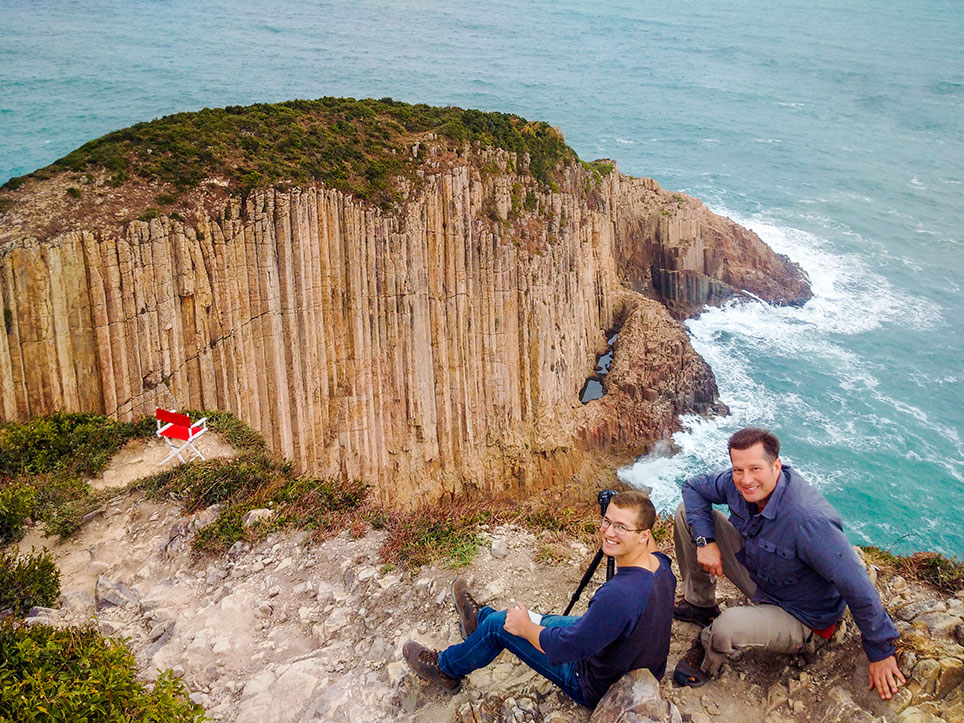
Wildlife
Do not disturb: Practicing ethical wildlife photography
Wildlife photographers on the thrill of the chase — and the importance of setting ethical guidelines
- 2849 words
- 12 minutes
People & Culture
As a new book of his images is released, photographer Randy VanDerStarren explains the meaning behind his well-travelled chair

It all started with a vision — and a chair. In 2018, photographer Randy VanDerStarren and his son Spencer set out to capture the beauty and diversity of our world, with a red and white director’s chair as a common element in each photograph. Over 40,000 photographs and 16 countries later, the chair continues to be a trusted traveling companion, and the VanDerStarrens have no plans to stop anytime soon. Their goal? To spread the message that it is possible for people to unite and take action towards the betterment of our one planet. The chair’s journey so far is captured in a new hardcover book that shares the name of their project: Take Your Seat. Here, Randy VanDerStarren talks about the project’s message, getting the perfect shot, and where the chair is going next.
So far, we’ve been to 16 countries and it’s the same chair in every photograph. If you see it at the top of a mountain or in the middle of the Sahara Desert, it’s actually there. We pride ourselves on telling these authentic stories. It’d be a lot easier to Photoshop the chair into these photos, but there’s something about the actual journey that shows in the photographs and reflects the stories of the people that we’ve met along the way.
For example, 2022 is the 60th anniversary of diplomatic relations between Canada and Thailand, so in April, we did an exhibition in Bangkok where we would show a photograph of our chair in a forest in British Columbia, and also a picture of the same chair in a forest in southern Thailand. Both the forests are coniferous and share common characteristics but what we thought was so beautiful about this exhibit was that when you looked at the two forests with the same chair in both, you start to realize just one example of how we’re more connected as human beings than people might think.
It’s not just in the case of landscapes either; through this series, whether it’s geology or people, we’re able to demonstrate our similarities and how we all want the same things. It doesn’t matter what colour our skin is or what language we speak; it’s really about recognizing at a heart level that there’s a human connection that binds us all together. I believe if we would focus a little more on that, the world would be a much better place.

The project uses a director’s chair for a reason. It’s meant to symbolize that you are the director of your life and you have the ability to impact the world around you. We knew when we started the project that we wanted a symbol but we weren’t quite sure what that was going to be. However, my degree is in film and so the director’s chair naturally arose from that background. It’s also an important symbol since, despite coming from various backgrounds, all the people in the photos are connected by this one piece of furniture. When you first see it, you’re probably wondering why the chair is in that photograph, but that’s what we want. We want you to start that conversation by asking that question.
We were in Morocco in April of this year, in the middle of the Sahara Desert, and at 4:30 in the morning, we got up with our camels and our guide and by the light of a full moon we started walking. We had to walk quite a few hours, but eventually we found what we thought would be a perfect spot and put the chair in place. The camel and our guide both decided to take a nap, but we just kept waiting and waiting and ended up with a stellar shot.
For us, it’s a bit different than pulling out your phone and getting a good picture, since before we can take a great photo we have to creatively place that chair in that shot. This means the lighting may be beautiful for a sunset, but not so beautiful where you have placed the chair. It takes a lot of planning and luck to get that chair in exactly the right place. We also have to carry the chair, plus all of our camera gear and any supplies that we need, like water, food, and clothes, so it can be a bit of a trek.

It’s the same chair in every country, every photograph. It’s been beaten up quite a bit, but it becomes more and more valuable every trip. To me, it’s no different than the fact that we only have one planet. It’s symbolic for us, since we know if we had ten other identical chairs in the trunk of the car, we wouldn’t take nearly as good of care of them. If we lose this chair, we’re done. We’ve had a couple of close calls with wildlife where they’ve decided to get a little more friendly with the chair than we would’ve liked. We’ve also had experiences where the chair has been in a crowd and we would hide somewhere far away to capture a good shot, but someone would wonder what the heck the chair was doing there, and pick it up and walk away. We’ve had to chase them down but there was never any harm done and so far the chair has remained intact throughout the journey.
We talk a lot about the phrase, “One people, one planet, one life,” and the chair, on the “one people” side, is really about that human connection from the stories we hear on our journeys. The “one planet” side is the work we do with various organizations to remind others that as a director of your life, you also make choices as to whether or not this planet’s going to survive. Lastly, the “one life” side of it is holding yourself accountable; are you living the best version of yourself? Are you doing what you said you were going to do? Are you following your passion? Spreading this message has always been a continual goal.
[Since the book went to print], we’ve already shot in two other countries, so we’ve been to 16 total. We’re about to go back to Turkey for the sixth time. Overall, it’s this continuous human journey that this chair takes us on. It sounds strange at first to think that a piece of furniture can have that kind of human connection, but we’ve had ambassadors [sit in it], we’ve had heads of major companies, we’ve had kids. There’s been such a wide range of people that have had their portrait taken in this chair and we are excited to continue documenting these stories.
Are you passionate about Canadian geography?
You can support Canadian Geographic in 3 ways:

Wildlife
Wildlife photographers on the thrill of the chase — and the importance of setting ethical guidelines

Wildlife
An estimated annual $175-billion business, the illegal trade in wildlife is the world’s fourth-largest criminal enterprise. It stands to radically alter the animal kingdom.

People & Culture
In the April issue of Canadian Geographic I wrote about Stratford, Ont.'s three decade struggle to repurpose the giant, neglected railway…

Wildlife
This past summer an ambitious wildlife under/overpass system broke ground in B.C. on a deadly stretch of highway just west of the Alberta border. Here’s how it happened.